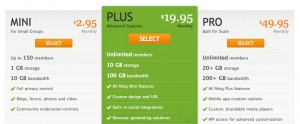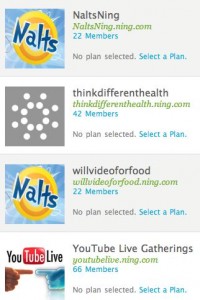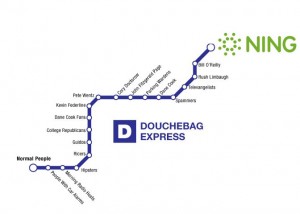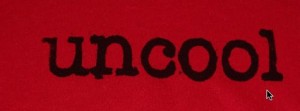I’m a capitalist. There I said it. I like free, but I respect fee-based services for valuable solutions. Innovators should get paid, and heavy users should open their wallets.
There are two ways to transition between free and paid: fair and uncool. Let’s examine two models for each, and explain why Ning (who failed at free social-media networking) wins the 2011 “WillVideoForFood Douchebag Award.” If you’d like to add your voice, see my Ning comment on Amplicate. If I would have done more homework (Charting Stocks) I might have known that “pulling a Ning” could mean a lot more than the way I’m using it.
Fair: Model 1 (trial and optional purchase)
A user tests a product or service for a designated trial period, then decides to buy or not. Many software solutions (like Prezi, and many video-file converters) offer this option, which is especially helpful in a crowded, undifferentiated market. If it works to solve a user’s immediate problem, and I often buy the tool even if I’m not sure I’ll use it. I want to reward the effort, and I’m grateful.
Two observations about how to screw up this model:
- Begging: I’ll admit that I don’t often yield to guilt/charity pleas until I’m a regular user and can no longer bear the pre-launch Sally Struthers appeal. I’d prefer an upsell for an additional feature/benefit.
- Watermarking/limits: Don’t stunt your trial offering with watermarks and functional limits. It’s annoying and I usually ditch it and look for an alternative.
Fair: Model 2 (trial, upsell for enhancements)
A user experiments with a software or service (Gmail, YouSendIt, Flickr) and is then upsold to higher-feature options (more storage, faster service, easier tools, advanced analytics). I’ve tried many things for free, and paid for more advanced features with important benefits. I was delighted to pay a modest annual Gmail enhanced-storage fee, and would be happy to pay for more Google services. YouSendIt limited my file-size limit, so I reluctantly paid since I often send large files. Now I’m thinking I could do the same thing for free “on the cloud” or via my more complicated FTP hosting on Bluehost. And Flickr? I paid for a dang “pro account” because I got tired of seeing a damned yellow message that looked like an error. I suppose this is fair (I could have ignored it), but I despise these alarmist approaches, and it means I’ll probably migrate off Flickr eventually.
Now the uncool options…
Uncool: Model 1 (auto-charge after trial)
You force the person to automatically pay after a trial service. That appears fair, but it’s not. We typically forget to cancel if the software doesn’t work. This model would be fair if the fee/charge was initiated automatically, only based on the ongoing use of the software. However it often moves to pay-per-month whether we use it or not. Uncool.
Uncool: Model 2 (surprise mandatory charge with content held hostage). Aka: “Pulling a Ning”
Ning inspired this post for pulling the biggest douchebag move I can recall. I created about 4-5 Ning sites purely because they were easy and free. But they’re small, and certainly not worth more than $10 a year (what I pay almost weekly to park a random domain). These ning sites were created purely because they were free and ad supported. If they were something I often used, I’d happily upgrade to a modest annual charge. However I barely used them and they’re not worth much.

This week I needed some content I’d placed on these ning sites, and found I couldn’t access them without paying. Today I received some e-mails about people wanting to join an old ning, but it would require me paying $60 to $600 smackers a year. Hey that’s certainly a fair price if I was a heavy user and had some strategic or economic goal attached to my ning communities. In fact it’s a fantastic price if you compare it to custom creation of advanced social-media tools. I used to urge clients to use Ning instead of having an agency stitch together a custom platform (I hope none of them listened to me).
I’m not criticizing the price point, but I’m not happy with getting Ninged. I’m abandoning all four of these nings because none are worth the price. More importantly, I created them based on my trust in Ning and Marc Andreessen (brainchild of Ning and Netscape founder). I’d like to see Netscape pull a Ning. I’m not aware if I can even access these nings to retrieve the content, or how to identify the community members who I may want to contact about a new location. For instance, “YouTube Live” members should move to YouTubeGatherings, which is a Ning site for which podcasting101 must have decided to pay. Even more frustrating I found my ThinkDifferentHealth Ning overtaken by spam bullshit. It’s embarrassing.
Ning CEO Jason Rosenthal wrote last April (2010) to his 40-percent-reduced employees “We will phase out our free service. Existing free networks will have the opportunity to either convert to paying for premium services, or transition off of Ning.” Note: I probably missed some e-mail announcement about an interim time period during which I could “transition,” but that no longer seems possible or at least intuitive. My content and content is held hostage, and the “transition off” feels more like getting locked out my own house.
 Let’s now envision what would happen if other social-media and online tools pulled a “Ning.”
Let’s now envision what would happen if other social-media and online tools pulled a “Ning.”
- Facebook locks you out this morning. You’ve got to pay $100 to access your account, or start all over back on MySpace.
- Your YouTube videos will be deleted in March unless you pay $5 per video. Instructions for downloading them (recovering them) are buried in the Google help website, and require advanced HTML coding to retrieve.
- Gmail decides to charge $50 a month, and if you don’t sign up for an annual contract you lose all of your contact addresses, e-mails and attachments by Wednesday at noon. Anyone writing to you after that point will receive a spam e-mail.
Presumably these more reputable companies would provide a transition period, and give you time to migrate. Furthermore I suppose I “hack” this by signing up for one month of ning for each of my sites retrieving my content/contacts, then canceling. But it’s too much work… and I’ll probably forget to cancel.
The bottom line is many companies made promises based on predominant unrealistic assumptions: They expect advertising to offset their costs, they expected costs to drop, or they expect more people to migrate to fee-based options. When they discovered their crystal balls were muddy, they faced their own unfortunate and more disturbing consequences than mine (lost money, fired people, disappointed investors). But in sharing their failure with us (trusting customers( they’ve created distrust). Yahoo Video is phasing out user-generated content, but I hope and expect the existing content to be “grandfathered.” To my knowledge, even my Google Video and Revver content still exists, and can be edited… even if I don’t continue to upload new videos to them.
Would you pay $600 to Ning, knowing they might either shut down the site, or tripple the price at will? Would you upload videos to a site created by Ning founders knowing they might delete or hold them hostage? Would you willingly create a new free profile on anything founded by Marc Andreessen?
This post was inspired by Ning but it’s meant to bring attention to both companies and customers on the broader implications. Companies: please don’t offer a free service unless you’re sure it can sustain perpetually — especially if “switching costs” for customers/users will be high. And customers/users: let’s pick our “free” solutions carefully. Are you sure about Tumblr, About.me, and other “free” profiles?
Today’s “free” could be tomorrow’s Ning.



I never liked Ning anyway and I wouldn’t care if facebook locked me out. I’d be helpless and enraged if YouTube/Google held my data hostage though.
P.S. Your about.me page looks awful.
Ashame about netscape. It used to be like Chrome, Slim and fast. Then it became a processor and memory dog.
I don’t thing Ning’s switch was planned, BUT a terrible thing they did. Since you use gmail, you should use Google Calendar to set your events. I know it is a stretch for you, but you could set an alarm for yourself to cancel services.
Try Weebly. I had several accounts on NING and deleted them. NING’s platform was just tired and outdated.
I like Weebly for the most part it’s free, very easy to use and has many different apps especially if you have a Youtube account and want a website to promote it.
http://www.weebly.com
NING’s switch over to paid accounts is really old news and back then they did give people a lot of warning.
Other things can go heywire too. A Flickr member “accidentally” had all their photographs deleted by Flickr recently. I would suggest the caveat here is to use whatever services you like but always back up your own content.
@4 Yeah, Kevin probably missed the warning emails.
That Flickr dude did have all his content backed up and Flickr did successfully restore his account and gave him like 25 years of free pro account.
Dude, youre upset about getting ninged? I havent been ninged in 16 years. At this point, i’d pay to get ninged.
Sukatra- thanks. I’m gonna leave my laptop and get ninged like crazy
Thanks view ferry.. trying to weebly.
My weebly is amazing. http://nalts.weebly.com/
I got Ninged today.